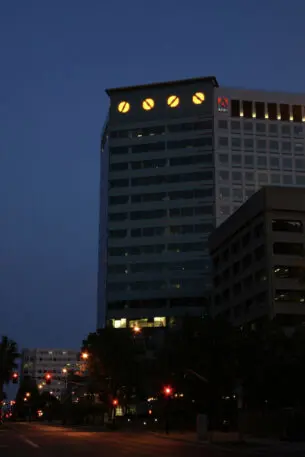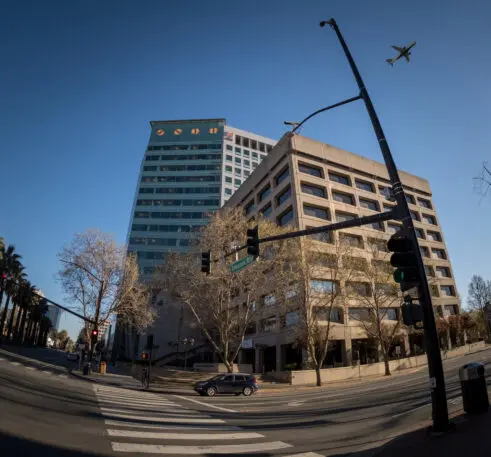The LED screen is 70 feet wide and contains four lighted disks, each 10 feet in diameter, with a line down the middle. Each disk can assume four positions, and the positions change every 7.2 seconds as they spin to reveal a new pattern.
That pattern is a riddle, and it took nearly four and a half years for someone to solve the previous one.

Known as a semaphore—a type of optical telegraph that uses symbols to transmit encoded information—the installation was designed by media artist Ben Rubin and is located on the 19th floor of Adobe’s Almaden Tower in San Jose. (The original Semaphore Telegraph was invented in 1792 and was the first mechanical system for long-distance communication.)
“There are times where I’m coming from the airport and I can see it,” says Eric Kline, director of global workplace experience at Adobe. Indeed, a version of the San Jose Semaphore (the official name of Rubin’s interactive art installation) has been a part of the city skyline for the past 17 years. The first semaphore design launched in 2006—it was solved in six weeks by two research scientists who outlined their process in an 18-page white paper. (The message was the full text of Thomas Pynchon’s 1966 novel The Crying of Lot 49, encrypted with ASCII characters.) The second semaphore was launched in 2012 and solved some five years later by a high school math teacher from Knoxville, Tennessee. (It was an audio file of astronaut Neil Armstrong’s famous line, “One small step for man, one giant leap for mankind.”)
Now, a new code is ready to be cracked, and it could be anything. “I’ve noticed it continues to evolve both in respect to the type of design as well as maybe the language or the message,” says Kline, noting that, aside from the artist, only one other person at Adobe knows what the new message is, mostly so they can coordinate everything with Rubin.

The San Jose Semaphore is unusual for public art, given that the majority of public artwork lives at street level where people can appreciate and experience it more tangibly. Art is often made to be passively consumed in the public sphere—sculptures and installations, however poignant or playful, don’t demand much brainpower.
By comparison, Adobe’s semaphore is a head-scratching brain teaser. Each disk of the semaphore can assume four positions: vertical, horizontal, left-leaning diagonal, and right-leaning diagonal. Together, the four disks have 256 possible combinations, and we don’t know the encryption technique.
Those who don’t live in San Jose can follow the disks on a web simulcast that operates around the clock. The visual code is accompanied by a soundtrack, which you can also listen to online, and sounds to me like a garbled yet oddly catchy soundtrack composed of mysterious guitar strings, Predator clicking sounds, and lulling voices spelling out numbers and various words from the NATO phonetic alphabet.
Sure enough, the San Jose Semaphore can seem exclusionary to some—I, for one, could never dream of solving it. But it’s intriguing. “Being able to interact in a way where it’s kind of a challenge is a unique idea, and we love it,” says Kline. “It’s a little bit more than just viewing.”
To prove you’ve cracked the code, you must document your process and show how you recorded the transmission, analyzed the message, and solved the cipher. It might take some time until this one is solved, but whoever ends up cracking the code will be awarded a two-year subscription to Adobe Creative Cloud—and my eternal personal admiration.
Recognize your brand’s excellence by applying to this year’s Brands That Matter Awards before the early-rate deadline, May 3.
